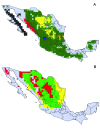Ecologic niche modeling and potential reservoirs for Chagas disease, Mexico
- PMID: 12095431
- PMCID: PMC2730326
- DOI: 10.3201/eid0807.010454
Ecologic niche modeling and potential reservoirs for Chagas disease, Mexico
Abstract
Ecologic niche modeling may improve our understanding of epidemiologically relevant vector and parasite-reservoir distributions. We used this tool to identify host relationships of Triatoma species implicated in transmission of Chagas disease. Associations have been documented between the protracta complex (Triatoma: Triatominae: Reduviidae) with packrat species (Neotoma spp.), providing an excellent case study for the broader challenge of developing hypotheses of association. Species pairs that were identified coincided exactly with those in previous studies, suggesting that local interactions between Triatoma and Neotoma species and subspecies have implications at a geographic level. Nothing is known about sylvatic associates of T. barberi, which are considered the primary Chagas vector in Mexico; its geographic distribution coincided closely with that of N. mexicana, suggesting interaction. The presence of this species was confirmed in two regions where it had been predicted but not previously collected. This approach may help in identifying Chagas disease risk areas, planning vector-control strategies, and exploring parasite-reservoir associations for other emerging diseases.
Figures





References
-
- Ryckman RE. Biosystematics and hosts of the Triatoma protracta complex in North America (Hemiptera: Reduviidae) (Rodentia: Cricetidae). University of California Publications in Entomology. 1962;27:93–240.
-
- Lent H, Wygodzinsky P. Revision of the Triatominae (Hemiptera: Reduviidae) and their significance as vectors of Chagas disease. Bull Am Mus Nat Hist. 1979;163:125–520.
-
- Peterson AT, Stockwell DRB, Kluza DA. Distribution prediction based on ecologic niche modeling of primary occurrence data. In: Scott JM, editor. Predicting species occurrences: issues of scale and accuracy. Washington: Island Press; 2001.
-
- MacArthur RH. Geographical ecology. Princeton (NJ): Princeton University Press; 1972.
-
- Gomez-Torres R, Rodríguez-Vázquez ML, Mooser-Barandum O, Ramirez-Isunza JM. Enfermedad de Chagas en el estado de Aguascalientes. Arch Inst Cardiol Mex. 1983;53:139–42. - PubMed
Publication types
MeSH terms
LinkOut - more resources
Full Text Sources
Medical
Miscellaneous
